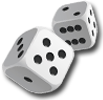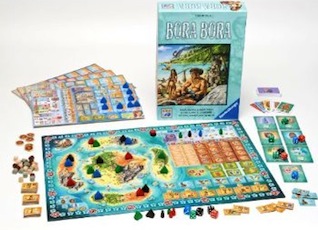



play board games
Board game reviews, strategy tips & session reports
Bora Bora Board Game Review
 Stats:
Stats:
No. of players: 2-4
Amount of time to play: 60-120 min
Age requirements: 12+
Set-up time: 5-10 min
Bora Bora is a eurogame that uses dice placement to perform different actions and complete tasks. The game only last six turns so you need to choose your actions, tasks and goals wisely to win.
Bora Bora Board Game Rules Description:
A game of Bora Bora is made up of six rounds and each round is divided into three phases. You must score the most VPs to win the game.
You start with a god tile, two god cards and two offerings. Starting order is determined by randomly handing out the order tiles. In reverse player order you may place one of your huts on the island and gain the resource associated with that area.
To begin the first phase you roll your three dice. In player order you place a die on one of the available actions. To place a die on an action tile its value must be lower than any dice currently on the action tile. When taking actions on the main board you are limited by which die you placed to use that action. You may always choose to use a lower value when interacting with the main board, but not a higher one.
The actions available to you are to expand, man, woman, helper, temple, build, or fish. The expand actions lets you place more huts on the map. The new hut must be placed in an area that is adjacent to one of your other huts. A man or women action lets you take the corresponding tile from the main board. These tiles give you extra action in the second phase of the round. The helper action lets you get more resources, god cards and offerings. You can also move huts to open up space on your player board and shift your men and women tiles for a one-time tattoo or shell bonus. In phase three, tattoos score you points and determine turn order and shells are used to buy jewelry. The higher your roll the more helper actions you can do. Temple actions let you put priests in the temple and take a fire action (which I’ll explain below). The priests score you points in phase three and might get you a god tile too. The build action requires resources and gets you points and a fire action. The earlier in the game you build the more you score. You can always take the fishing action no matter what dice are already there. It simply scores you two VPs.
In phase two, in player order, you may take an action with one man and one woman currently on your player board. If you have two of the same tile you can double that action.
In phase three you change the player order based on who got the most tattoos that round. Then you score points for the number of priests you have in the temple. The player with the most priests also gets a god tile. Next, in player order, you may buy one piece of jewelry. And last you may complete one task on your player board. Tasks are varied and require you to have a certain number of resources, men or women tiles or even god cards. Other tasks require you to have huts on specific terrain or buy a specific type of jewelry. If you cannot complete a task you must discard one. To end the round you get a new task from the ones currently on the main board, again in player order.
Before starting the next round you remove the men, women and tasks tiles from the game. Then draw new ones and place them on the main board.
God cards allow you to get around some of the rules but require you to discard an offering to use. One god card lets you place a die on an action no matter the value. One scores you extra points when you pace a hut. One treats your roll as a six for the action you take. One allows you to take a men or women action twice. And one lets you complete a task without fulfilling one requirement, but scores you less points. A god tile can be used to mimic any god card but doesn’t require an offering to use.
A fire action lets you get a god card or an offering and a tattoo or a shell. Fire actions are only available after a build or temple action.
In the sixth and final round after you select a new task tile you may complete as many tasks of your last three tasks as is possible. You score for them and then the game is over. Then you score bonus points for completing different goals like completing nine tasks, getting six jewelry tiles or building all six building tiles. You also get two VPs for each unused god tile. The player with the most VPs wins.
Quick Review of Bora Bora Board Game:
Bora Bora has a lot going on and there are different avenues that can lead you to a win. Good strategy and some luck are rewarded in this board game. And you need to react to the current tiles and your dice rolls too.
This game looks great. There are a lot of tiles and wooden bits in the game and they are top quality. The art is bright and fits the tropical island theme. The rules are well organized and written, but there are a lot of them. You probably want to read them try a few turns solo and then read them again before you teach your friends. The player boards are a bit busy but once you learn the game you’ll appreciate the information they contain.
I really like the way the dice and actions interact in Bora Bora. Rolling high gives more options on the main board, but you can only place a die lower than one currently on an action. This means you might not get your high die on the action you’d like. This creates tension and meaning when choosing which die to play when and where.
Even though dice are involved, Bora Bora is not a total luckfest. You start with a god tile and two god cards. These can help you negate some of the luck factor. You still may have a turn where you can’t use a die but it doesn’t happen too often.
I like the structure of the game and how the actions are interconnected. If you want to add more men and women then you need room on your board. This means you need to use an expand action to get the hut from your player board to the main board. You could also use a helper action to move the hut to your 12th space. But the point is the actions play off each other. If you can get the actions you are taking to flow with some of your tasks you can start scoring points in bunches.
Be warned though this game can be overwhelming. The richness in the variety of actions and all the ways to score and win comes with a learning curve. It will probably take a couple plays before you really get this game. And teaching it two new players is not easy. That said it is worth it and anyone you teach will be glad you did.
The only other thing not to like about the game is the set up and tear down time. There are a lot of things to put in piles and and set on the boards. It is not extraneous but just keep in mind it will take some time.
Bora Bora is a fun board game with some good depth. And though it may take you some time to learn and understand, it is worth it. It may not go over well with your non-gamer friends but most gamers should enjoy Bora Bora. If you get the chance you should try the game out. If are a fan of Stefan Feld you’ll like this one, so check it out.
Score and synopsis: (Click here for an explanation of these review categories.)
Strategy 4 out of 6
Luck 5 out of 6
Player Interaction 4 out of 6
Replay Value 5 out of 6
Complexity 5 out of 6
Fun 5 out of 6
Overall 5 out of 6

Leave a Reply